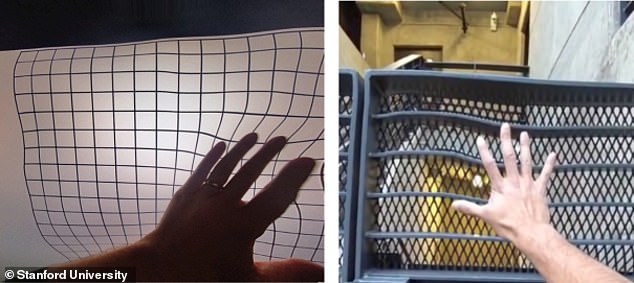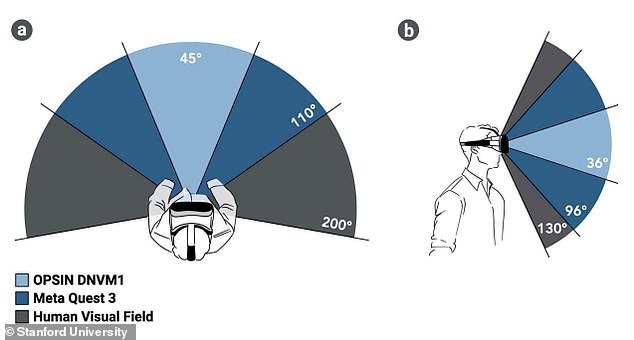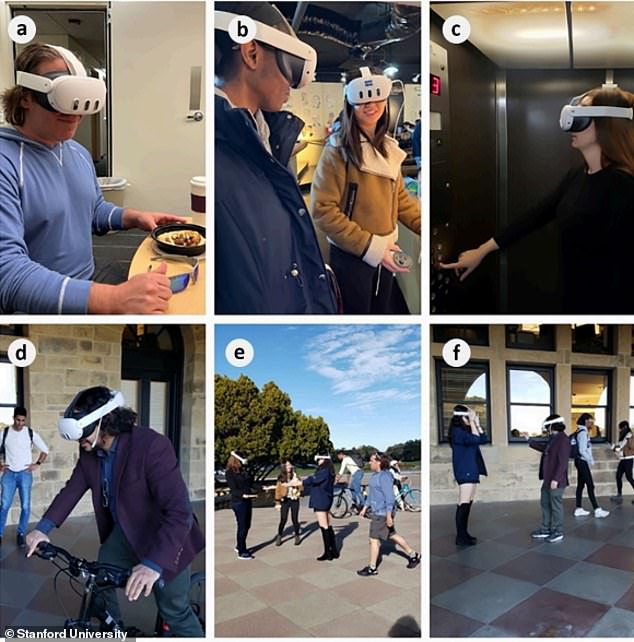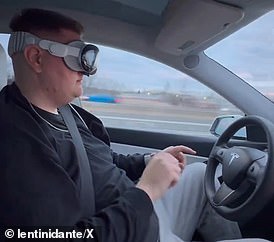Apple’s Vision Pro headset could distort reality in new ways, generating a world that looks different for everyone.
In the wake of the Vision Pro’s release, researchers set out to discover what long-term use of a virtual reality headset would do to our cognitive functions, and what they found was alarming.
A team of 11 researchers at Stanford University and Michigan University took turns donning several passthrough headsets, including the Vision Pro, the Quest Pro, the Quest 3, the Varjo XR-3, and various night Vision Goggles.
The so-called ‘passthrough’ technology intermixes the real world with virtual reality that might be somewhat off-center from what we’re used to and can distort our sensory functions and how we move through the world.

Researchers reported the passthrough headsets distorted what they saw and made objects appear curved instead of their normal, straight appearance

Researchers tested the Vision Pro, the Quest Pro, the Quest 3, the Varjo XR-3, and various night Vision Goggles – and found the Quest 3 removed walls that existed in reality
At first, the researchers had a difficult time navigating while wearing the headsets in both public and private spaces, noting that objects seemed closer or farther away than they were.
They walked with someone nearby to help them in case they tripped or walked into anything and initially reported feelings of nausea, eye strain, headaches, and dizziness – all signs of ‘simulator sickness.’
One of the most widely accepted theories about why simulator sickness occurs is the sensory conflict theory, in which a person experiences mismatches between the visual system, our sense of balance, and the body’s ability to sense movement or the location of a place or object.
The researchers found that one of the most critical issues with the passthrough headset was distortion which showed the world as if through a prism or funhouse mirror.
‘Anyone who has spent time in a museum’s hall of mirrors that make people appear taller, thinner, or curvier understands this concept,’ the researchers wrote in the study.
The headsets distorted straight lines, making the edges appear curved and either expanded or compressed the distance between objects.
Researchers reported having trouble pressing the button on an elevator because the buttons appeared farther away from their fingers or experienced difficulty bringing food to their mouths.
‘Because wearing passthrough technology involves seeing the world through a small number of cameras, there is often a discrepancy between the location of a user’s real eyes and the location of the camera display,’ the study said.
But after a few hours of wearing the Vision Pro, the researchers noticed their brains were adapting to the virtual world, and picking up objects or navigating while wearing the headset wasn’t difficult.
‘These headsets can not only add things to the real world, they can also delete them,’ Jeremy Bailenson, the study’s lead author and director of the Virtual Human Interaction Lab at Stanford told Business Insider.

A team of 11 researchers at Stanford University and Michigan University tested the headsets on campus to see how it distorted what they would normally see
He told the outlet that he realized the headset was editing his surroundings while he was playing a Quest 3 game, saying it ‘knocked out’ portions of the walls around him in the real world, and replaced it with a virtual scene.
‘I’ve been doing VR and AR for a while, and I had never in my life seen deletion work so well,’ he said.
Although the researchers’ senses adjusted to the passthrough technology, when they took off the Vision Pro headset, they noted that their perception was reversed, and it was now the real world that looked distorted.
Researchers compared the experience to wearing prism glasses that make objects appear to shift to one side, and you might miss trying to reach for something at first because your brain and eyes are used to working together one way.
But after wearing the glasses for several hours, your brain will adjust to figure out where your hands reach so you can grab things despite it looking off-center, but when you remove the glasses, your brain won’t automatically readjust to the normal levels of perception.
‘When you take off the glasses, the brain still wants to move your hands as if everything is shifted, resulting in reaching in the wrong direction for a short time,’ the study said.
Not only did the VR headset remove walls and barriers, and distort the way the world appears, but it also resulted in delayed responses and missed social cues.
Bailenson and his team described the feeling as ‘social absence,’ – when people feel physically disconnected from others.
The study’s authors warn that based on their research and past reports, people should be wary of using VR headsets, saying people shouldn’t assume that virtual presence can replace face-to-face interactions.
Reduced in-person contact could cause distrust in others or cause people to become ‘non-people,’ meaning they aren’t fully present.
‘What we’re about to experience is, using these headsets in public, common ground disappears,’ Bailenson told BI.
‘People will be in the same physical place, experiencing simultaneous, visually different versions of the world. We’re going to lose common ground.’
The authors noted that more research needs to be conducted to understand the long-term effects of continuously wearing passthrough technology, like the Vision Pro headset.
‘It may be difficult to imagine the world portrayed by the movie Ready Player One, where everyone emulates [the characters] wearing headsets all day long in their public and private lives,’ the researchers said in the study.
They continued: ‘Few people can even fathom a norm in which face-to-face interaction becomes largely mediated by passthrough headsets.
‘But the largest technology companies are telling us, very transparently, that they are building this world. We should listen to them.’












